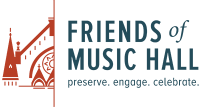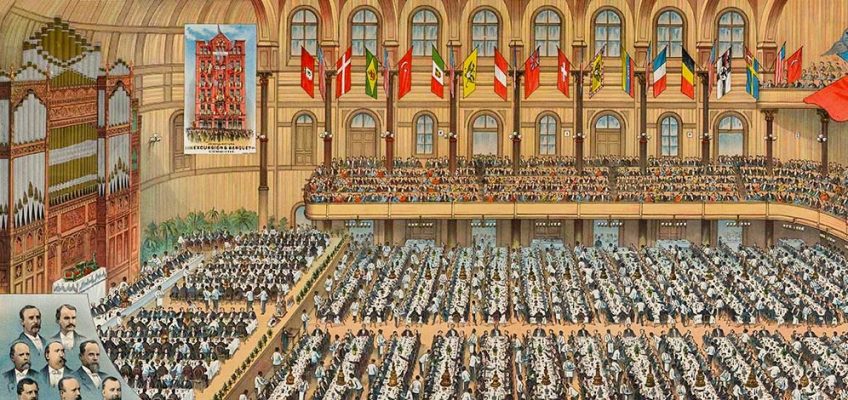When you want to celebrate the success of a monumental undertaking, you throw a party, right? That’s what Cincinnati did in 1880, following ten long years of work to build the Cincinnati Southern Railway between here and Chattanooga, Tennessee. Here’s the story.
The Queen City

By 1880, the city of Cincinnati was thriving—it was the largest city in Ohio. The city boasted the densest population of any city in the U.S.
Businesses were booming. The city was seen as the founder of Industrial Expositions, with a new one each year. Major industries included meatpacking, woodworking, iron production and carriage making, Culturally, the city boasted the new Music Hall, the bi-annual May Musical Festival, an Art Academy, Public Library, two well-regarded music schools, and Natural History Society.
Add to that: Cincinnati became the first municipality in the country to build and own a major railroad. The Cincinnati Southern ran from here to Chattanooga, Tennessee.
Best of all: it didn’t cost the citizenry (aka taxpayers) a cent! And since was leased to the Southern Railway System. The terms of this agreement added some princely sums to the city coffers, and continues to do so today.
The Marketing Strategy
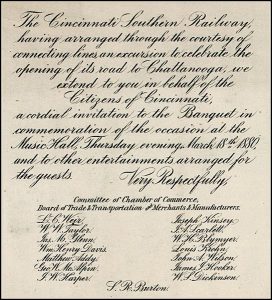
To celebrate the opening of our great Southern Railroad, the Chamber of Commerce, Board of Trade and top local merchants came up with a plan.
They would invite their counterparts in the South to take an inaugural excursion on the newly-completed railroad to Cincinnati to see what the city had to offer, and to attend a grand banquet in Music Hall on 18 March 1880. All this—and a parade—at no cost to the recipients.
They estimated that Music Hall could seat around 1,770 people.
It would be the greatest and largest banquet ever given in the U.S!
If You Build It…
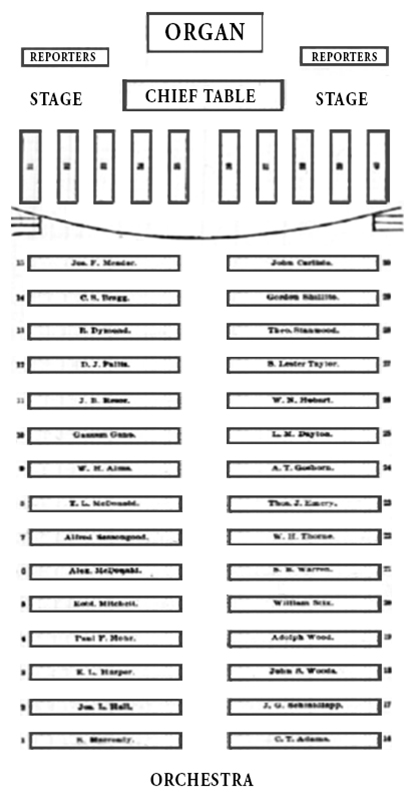
Three very long trains brought delegations from Alabama, Georgia, South Caroline and Tennessee. The guests were cordially welcomed from the city core to the hilltops and beyond.
Businesses were decorated. A parade was held. After dark, fireworks entertained both visitors and residents. Special committee members met delegations at their hotel and escorted them around the city.
In preparation for this incredible party, Music Hall’s south wing was converted into a huge kitchen. The north wing was assigned the enviable task of being a wine cellar. As each place setting featured five wine glasses, thousands of bottles were needed. We’re told the wines were “rich, rare and heady.” The wine list and menu are included, below.
The stage area and the entire floor was filled with 40 tables. (Total length: a quarter of a mile.) The band, normally on stage, was relegated to a raised platform in the balcony. Each table was headed by a “host” Cincinnatian who ensured the city’s guests received everything they wanted.
A Floral Delight
Each guest received a boutonniere, but that’s just the start of the décor. Pastries and elegant floral arrangements decorated each table. Before dinner was served, the hall was filled with the fragrances of calla lilies, tuberose, lilies of the valley, roses and smilax.
The Hook & Hastings organ was decorated with an 8-foot long locomotive designed in pink and white flowers.
Music Amid the Celebration
The program for the event included performances on the Grand Hook & Hastings Organ. Also, the Cincinnati Orchestra Reed Band, conducted by Michael Brand, played throughout the evening. While each selection was applauded, the most enthusiastic response occurred when the orchestra played “Dixie.” The entire congregation stood and let forth a “rebel yell” during the chorus, and during “The Star Spangled Banner.”
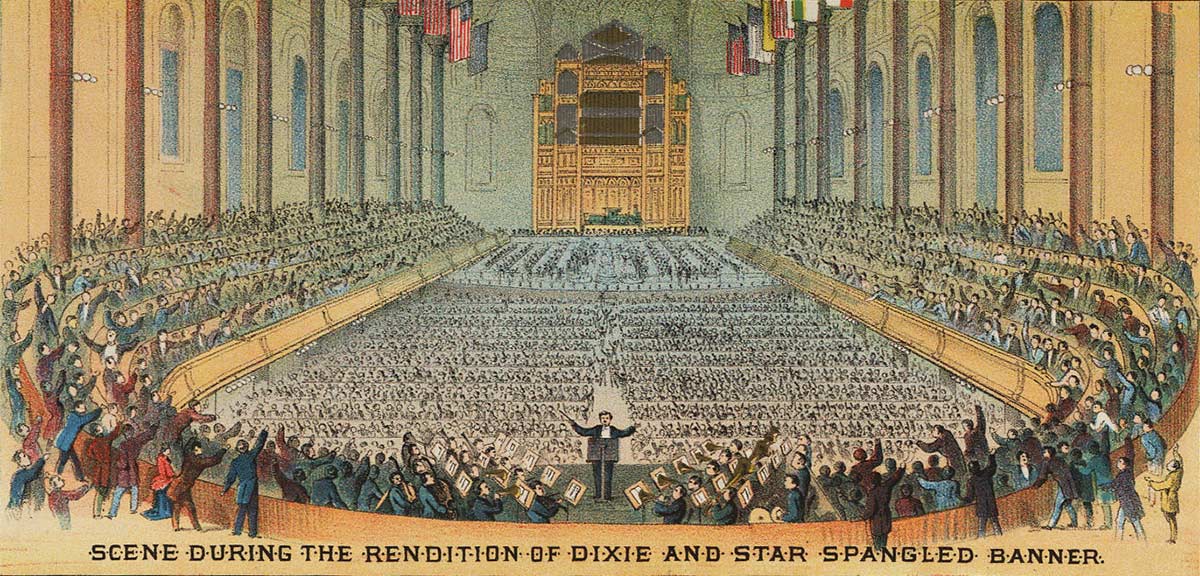
Life is a Banquet
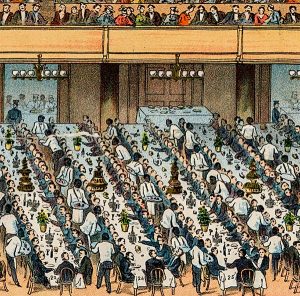
The following were among the dishes served:
- Blue Points on half shell
- Kennebeck Salmon with Hollandaise sauce
- Roast Sirloin Beef with Mushrooms, string beans and potatoes
- Chicken Croquettes and French Peas
- Roast Venison with Jelly
- Roast Mallard Duck with Port Wine Sauce
- Lobster Salad
- Various cheeses
- Wines included Haut Sauterne, Bordeaux, Sherry, Claret, and, of course, Champagne
- And for dessert, assorted ice creams, water ices, fruits, cakes and coffee
In all, the music, the dinner, a handful of toasts, and the speeches took the event well beyond 11pm.
The Feast, By the Numbers
Not including the planning committee, it took an army of people and a ton of food to pull this off.
- 43 head waiters
- 260 under waiters
- 81 wine servers
- 60 carriers
- 28 cooks
- 28 assistant cooks
- 20 washers
- 10 carvers
- 12 heads of departments
And dishes…
- 5,400 dinner plates
- 2,000 soup plates
- 3,600 dessert plates
- 9,000 glasses
- 4,000 knives, forks and spoons
- 10,800 oysters on the half-shell
- 100 gallons of soup
- 1,200 pounds of fish
- 1,000 pounds of sirloin
- 2,000 croquettes
- 1,000 pounds of venison
- 600 ducks
- 2 wagon-loads of potatoes
- 600 cans of peas and beans
- 100 gallons of ice cream
- 125 pounds of cake
- 75 gallons of punch
- 100 gallons of coffee
- untold “quantities of other sundries”
- 3,520 bottles of wine
- Three casks of sherry
- Sixty cases of sauternes
- 75 cases of claret
- 125 cases of champagne
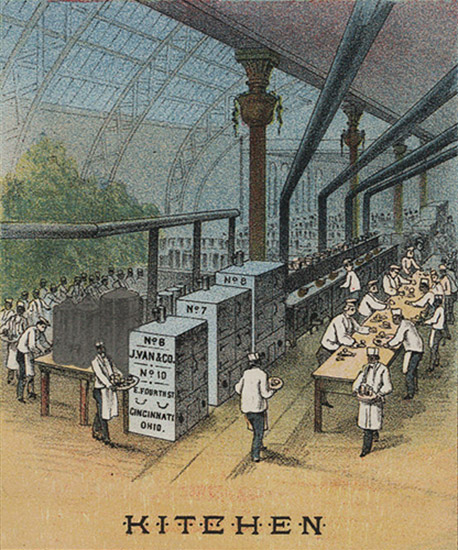
Originally, two mammoth “kitchens” were planned, one in the north and one in the south hall.
Each kitchen was said to be outfitted with:
- 14 large ranges
- roasting ovens
- steam tables
- untold number of tubs of ice
- a half-dozen tanks for soup and coffee
In 1880, these halls were separate buildings, so covered passages were constructed between them and the auditorium.
The Entire Effort was a Great Success
In addition to the banquet, the thousands of visitors toured manufacturing and wholesale houses, as well as packing businesses, that made Cincinnati the thriving metropolis of the era. They were also treated other, smaller banquets, and to theater tickets, lunch at the Zoo, and other attractions.
So – how did they get a great number of people to come to Cincinnati, to learn about and experience our city and its wonderful amenities? For the visitors, it was all free. A junket. The city fathers had raised enough money to cover the entire venture.
Additional Facts
While portions of the line were finished and used starting around the summer of 1877, the entire line wasn’t completed until February 1880. On February 21, the first freight train traveled from Chattanooga to Cincinnati and in early March, the first passenger train ran the route.
And that first passenger train had a nickname. Ever hear of the song “Chattanooga Choo Choo?” Here’s the song, as recorded for the film “Sun Valley Serenade” (1941) recorded by the Glenn Miller Orchestra.
The rail line represented a number of “firsts.”
- This was the first major link in north-south public transportation
- The Cincinnati Southern Railways was America’s first municipal railway system.
In case anyone asks, the City of Cincinnati still owns the Railroad, the only long-distance railway owned by a municipality in the U.S. The city leases it to the Cincinnati, New Orleans, and Texas Pacific Railway (CNO &TP).
However, in November 2022 the Cincinnati Southern Railway Board has agree to sell the railroad to Norfolk Southern, pending state and voter approval. The earliest this could appear on the ballot is November, 2023.
This post was originally published in March 2019 and has been revised to include additional information and photos.
